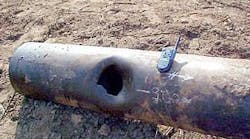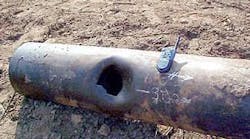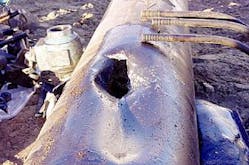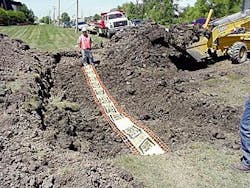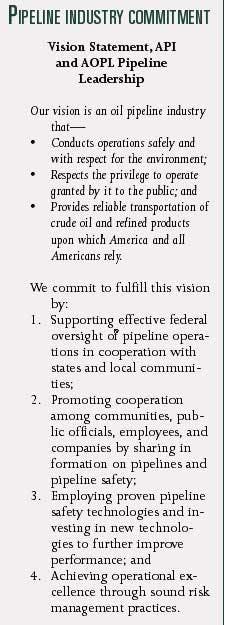The industry-wide Pipeline Performance Tracking System (PPTS) has been in place for 4 years (OGJ, Nov. 11, 2002, p. 68). Now that the US oil pipeline industry has a substantial amount of recent performance data, the American Petroleum Institute/Association of Oil Pipe Lines Data Mining Team can report on what has been accomplished, how it is useful to pipeline operators, and future plans.
Voluntary participation
PPTS, a spill-reporting system with voluntary participation in the oil pipeline industry, was one of the first mechanisms established by the US oil pipeline industry as it embarked on its campaign to improve performance in the late 1990s. PPTS provides the opportunity to focus on the spills ("manage what you measure") and to learn from the record.
It captures incident and infrastructure information with the detail necessary to examine both the specific accident causes and the specific parts of the pipeline system. PPTS now has 43 participating pipeline systems, representing about two thirds of US oil pipeline mileage and nearly 90% of volume transported by oil pipeline.
Over 1999-2001, there were 1,882 releases reported to PPTS by participating companies. Of these, 66% were smaller than 5 bbl, 20% were between 5 bbl and 50 bbl, and 14% were 50 bbl or larger. By design, participants report few details on spills that are smaller than 5 bbl but report considerable detail for spills of 5 bbl or more or for spills that involve a death, injury, fire, or explosion.
Even without detailed information, however, the small spills provide significant opportunity to learn. Just knowing the frequency and location of small spills was new and important information. For instance, more than half of the small spills were found to occur within pipeline facilities, such as pumping stations and terminals, rather than on pipeline rights-of-way where they would more likely impact the public.
Data mining
Collecting data and even aggregating the information do not provide the in-depth understanding that operators need to reevaluate or change processes, procedures, risk-assessment criteria, right-of-way communications, or any of the numerous activities involved in the safe and reliable operation of a pipeline system.
Therefore, when senior pipeline executives from the member companies of API and AOPL created PPTS, they also created a team to oversee data issues and quality, to conduct thoughtful analysis, and to convey to operators the messages illuminated by the data in the form of tables and charts, reports, and brief advisories. Thus, the Data Mining Team reports actionable information back to participating pipeline operators.
Each year, those executives review both the new findings and the team's analysis agenda to ensure that it is coordinated with the industry's other performance improvement initiatives.
The membership of the Data Mining Team is drawn from operators of different types of pipelines and represents various areas of expertise. Periodically, membership on the team is rotated to bring in fresh perspectives and to give all PPTS participants the opportunity to serve.
Serving on the team provides members with access to more detailed data compilations than can be effectively published and the opportunity to delve more deeply into particular topics of interest.
During the past year, the team has been taking an in-depth look at a number of important topics: corrosion, operator error, the public safety consequences of pipeline accidents, third-party damage, and facilities or piping and equipment.
There were specific reasons to focus on each of these classifications. In some categories, the attention came because the incidents were numerous, even though they were small in volume. The team, however, took particular care to focus on the incidents that affected public safety. While these incidents are rare, they must be the first to receive attention in the quest for improved performance.
Work on third-party damage
Because third-party damage incidents historically have produced the most serious consequences, the Data Mining Team examined the PPTS record of these types of releases in particular detail.
A "third party" is a person not involved in operating or maintaining the pipeline. Examples include farmers, homeowners, construction crews, and excavators. These are people who in the course of their normal activities may come in contact with a pipeline and, by damaging the pipe, could cause a spill.
Third-party damage accounted for only 7% of the 1,882 spills reported to PPTS between 1999 and 2001, but it:
Accounted for 100% of the incidents involving a death.
Accounted for 52% of the incidents involving an injury.
Accounted for 28% of all incidents involving fire or explosion.
Accounted for 56% of all volumes released from onshore pipe.
Accounted for 54% of the largest 2% of all spills (more than 5,575 bbl).
null
In the detailed information available for releases of 5 bbl or more, PPTS classifies third-party damage into three groupings:
1. Third-party excavation, construction, or other work activity occurring at the time of the failure.
2. Third-party excavation, construction, or other work activity occurring at some time before the failure.
3. Other types of damage, including vandalism, third-party vehicular contact with a facility, and other intentional or unintentional acts.
Damage at the time of the failure (No. 1) accounts for the greatest share of incidents, by far, at 75% of all third-party incidents; prior damage (No. 2) accounts for 17%; and "other" damage (No. 3) accounts for 8% of all third-party damage incidents.
Damage at the time, 1999-2001
Onshore pipe within a right-of-way (as opposed to such other parts of the system as pumping stations or terminals) dominated third-party incidents involving damage at the time (No. 1 above), with 97% of the incidents and 97% of the volume released.
Hence, this section will focus on onshore pipe incidents, using the detailed information available for releases of 5 bbl or more, or those involving a death, injury, fire, or explosion.
PPTS participants provide information on the type of activity or party that caused the damage, which is important for assessing hazards and targeting prevention efforts. Table 1 consolidates some of the categories to enhance understanding and to simplify presentation.
null
null
- Farming activities account for the largest share of the incidents. Taken together with homeowner activities, they form a "landowner" category, which accounts for 37% of the incidents and 44% of the volume released.
Furthermore, there was a death associated with one of the homeowner incidents and injuries associated with two of the homeowner incidents and one of the farming incidents. These public-safety impacts underscore the importance of the category.
*The next largest category is presented here as "One-Call Partners." The category combines damage caused by other pipeline operators and by other underground operators (telecommunications, energy utilities, etc.), which are entities familiar with the One-Call notification program.
They fund the programs and receive requests to mark their own facilities, putting these entities in a unique position to understand the risk of mechanical and (or) excavation damage and its prevention.1
- "Additional Industrial/Commercial Activities" includes PPTS categories residential-commercial development, onshore waterway activity, rail construction, and the miscellaneous incidents reported as "other" damaging parties by PPTS respondents.
After review and analysis of the data, "Operator Considerations" are also developed as part of the advisory issued on the topics. Operators are encouraged to incorporate these considerations into their existing processes to improve operations and spill prevention.
Here are some examples related to third-party incidents:
- Operators should continue support for the development and use of One Call systems. PPTS operators have reported that failure to use One-Call was the primary cause of failure in more than half of the third-party damage incidents.
- Operators should continue educating the public regarding safety around pipeline facilities. Farming activities were the largest single activity responsible for third-party damage that resulted in a release at the time the damage was inflicted.
This is only a sample of the depth and detail of the analytical work on third-party damage that has been shared with PPTS participating systems.
Evaluating IM programs
PPTS has also provided a mechanism to evaluate progress on integrity management. The US Office of Pipeline Safety, within the Department of Transportation, promulgated the IM rules for hazardous liquid pipelines (large US operators) in 2001 with an effective date of March 2002.
Operators must have completed the baseline assessment for 50% of their highest risk lines by September 2004 and have completed all baseline assessments by March 2008.2 It is now less than a year from the 50% deadline.
The senior executives from API and AOPL companies and many pipeline operators quickly recognized that industry would need performance measures to understand the effectiveness of various IM programs and that these performance measures could not just be about releases.
Consequently, PPTS participants annually provide information on the use of different types of inline inspection (ILI) tools (corrosion and metal-loss tools, dent or deformation tools, crack or long-seam defect tools, and other tools), about hydrostatic testing, and about the actions taken based on inspections. This information will allow the PPTS participants to demonstrate the mileage inspected and the actions taken both within defined "high-consequence areas" and across all systems.
Different ILI tools are designed to locate different types of pipe defects and damage. Because a specific type of tool targets a specific type of pipeline defect or anomaly, any analysis of tool effectiveness must cross-compile the type of tool and the type of failure.
By using PPTS information on releases, the industry can evaluate whether a tool that was run was designed to identify the specific type of failure that occurred. Although not perfect, the compilations will provide indications about whether different tool technologies are meeting expectations and how operators may utilize tools and evaluate their recorded data more effectively.
The Data Mining Team has begun experimenting with analytical work in this area.
Companies use PPTS
In addition to the advantage of the analytical work based on the aggregate data, individual companies leverage their participation in PPTS in several ways. Here is just a sampling of how individual companies use PPTS:
- To assist in business decisions. One major pipeline operator is using PPTS as a performance benchmark in evaluating potential acquisitions. Another operator uses comparisons of system performance against the PPTS industry performance in discussions with public officials and agencies on right-of-way issues and siting of new pipelines.
- To drive internal performance. One operator uses PPTS as a benchmark to craft both positive and negative pay incentives for employees. Many operators use PPTS advisories (published to participating companies only) as part of safety meetings, risk-assessment evaluations, and to stimulate discussion for process improvements.
One operator stated, "Not everything that can happen has happened to our company; PPTS helps us in figuring out what we don't or can't know from our own experience." Another operator uses PPTS to spur productive competition between divisions within the company.
- To make risk-assessment tools and methodologies more effective and concrete. Several operators have used the PPTS work on the performance of pipe based on the decade of original construction to allocate resources, implement different IM systems, or make decisions on taking some pipe out of service.
- To drive company performance in relationship to peers and competitors. Several operators have used PPTS performance comparisons as incentives and specific measures for senior management and employees, including tying PPTS performance to incentive pay or bonuses, thus driving employee action for further improvements.
- To evaluate performance for external recognition. Many operators participate in API's Annual Pipeline Awards program, based in part on company performance as reported to PPTS. Annual winners of the awards are recognized at API's Annual Pipeline Conference and reported in the media.
Not only PPTS
As reflected in its vision statement (see accompanying box), the US oil pipeline industry is committed to error-free and spill-free operations. The industry is also committed to helping the US secure our critical infrastructure in the aftermath of Sept. 11, 2001. PPTS is only one investment in the future.
The oil pipeline industry is also:
- Increasing investment in research and development through membership and participation in the Pipeline Research Council International (OGJ, June 30, 2003, p. 17) and the R&D program of the Office of Pipeline Safety.
- Surveying operators to learn how they assess and mitigate specific risks–external corrosion, for instance, or mechanical damage. The Performance Excellence in System Integrity Team then compares the release record for operators that are using different combinations of assessment and mitigation techniques to identify the most successful mix of initiatives.
- Benchmarking to facilitate improvements in business practices through the API/AOPL Pipeline Benchmarking Survey.
- Improving educational information about the pipeline industry through www.pipeline101.org.
- Enhancing communication with the affected public along pipeline rights-of-way through API Recommended Practice 1162.
- Implementing security programs, conducting vulnerability assessments, and working with the US Department of Homeland Security.
Acknowledgment
In addition to the authors, other current members of the PPTS Data Mining Team are Hazem Arafa, API; Dave Knoelke, BP Pipelines North America; Dave Lemmon, Colonial Pipeline Co.; Larry Shelton, Buckeye Pipeline Co.; Marc Wolgamott, Koch Pipeline Co. LP; and Gary Zimmerman, Shell Pipeline Company LP.
Notes
1.Mechanical and excavation damage incidents caused by the operator (the PPTS respondent) or its contractor are classified as Operator Error rather than third-party damage and thus are not included here.
2.The baseline assessment includes a number of steps to evaluate the integrity of an oil pipeline segment, usually including inline inspection (ILI) using a variety of tools, popularly known as "smart pigs," followed by mitigation and (or) repair of any identified vulnerabilities.
The authors
Tom J. Kelly is environmental compliance manager for Colonial Pipeline Co., Atlanta, which he joined in 1989. Previous positions have included environmental team leader, regulatory engineer, quality-assurance coordinator, southeast district project manager, and Atlanta area engineer. Kelly holds a BS (1988) in chemical engineering from the University of Tennessee, Knoxville, and is a member of AIChE and ASTM.
Marty Matheson is general manager for pipelines at the American Petroleum Institute, Washington, and a member of the API management team. She has worked in several capacities for API, including technical writing, program management, contract management, and issues management over the last 25 years. Matheson holds a BA from St. Lawrence University and is a member of ASME and its B31.4 committee.
Jill R. Niswonger has been incident investigation coordinator for Marathon Ashland Pipe Line LLC since 1998 and has also served as risk-management specialist. She holds a BS (1995) in biology from Bowling Green State University, Bowling Green, Ohio, and an MS (1997) in environmental management from the University of Findlay, Findlay, Ohio.
Cheryl J. Trench is president of Allegro Energy Consulting, which she established in 1997. She also served as executive vice-president and other positions over 22 years for the Petroleum Industry Research Foundation Inc. Trench holds a BA in economics from the City University of New York, is a member and past chapter president of the International Association for Energy Economics and a member of the advisory board for New York University's Energy Forum.
Mark D. Weesner is risk and integrity advisor for ExxonMobil Pipeline Co. and has served as global supply advisor for ExxonMobil Lubricants & Petroleum Specialties Co. He holds a BSME (1980) from Texas A&M University, is a registered professional engineer in Texas, and is a member of ASME.
